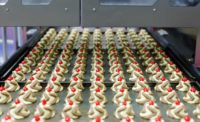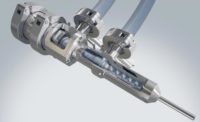CANNABIS PRODUCTS | JUNE 2020
Sanitizing Equipment for Safe Cannabis Edibles
Even without federal oversight, cannabis food and beverage manufacturers should follow GMPs for equipment cleaning and sanitization.






Whether manufacturers make cannabis-infused foods and beverages or non-infused ones, proper sanitation is a must to create safe, high-quality products.
And while there’s no federal oversight of cannabis-infused food manufacturing—and states have their own patchwork of regulations—manufacturers of cannabis products should still follow the rules governing non-infused food production, says Tim Robb, vice president, marketing and strategic business development, Goodway Technologies, Stamford, CT.
“Maintaining clean and sanitized environments built on well-defined good manufacturing practices (GMPs) and standard sanitation operating procedures (SSOPs), and staffed with professional sanitation and maintenance managers, will help increase the quality and safety of end products,” says Robb.
System Considerations
Many food manufacturers rely on clean-in-place (CIP) methods, which allow for the cleaning and sanitization of pipes, vessels, filters, fittings, and other processing equipment without disassembly. Alternatively, clean-out-of-place (COP) methods require equipment to be disassembled and moved from their positions to be thoroughly cleaned (for comprehensive federal guidelines for cleaning and sanitizing food and beverage production facilities, see 21 CFR 117).
Under both methods, cleaning systems should incorporate TACT principles—time, action, chemical, and temperature—developed in the late 1950s by chemical engineer Herbert Sinner. These principles determine the result of the cleaning process.
How they’re applied requires understanding the composition of the food product being manufactured. Aspects like solubility, total solids, product pH, and the potential for bacterial contamination and growth all might require consideration. Total loading of residual product particle adherence can also factor into sanitation requirements. This can be an issue with the sticky, highly viscous cannabinoid oils used in manufacture of infused products.
It’s also important to only use sanitation methods and systems specifically developed for use in food-contact manufacturing environments, says Robb. “Is the technology implemented explicitly developed for food production environments? For example, does it include cleanable surface or industrial design with limited food collection areas?”
Another element to consider is the total cost of ownership—and not just for the equipment itself. Labor, water usage, and chemical usage are expenses to factor in, as well.
The type of chemistry also makes a difference, says Keith Cronce, director of PathoSans/Klarion Groups, Spraying Systems Co., Wheaton, IL. Some cleaning and sanitation systems rely on purchased chemistry, while others produce it onsite, eliminating the need to purchase chemicals from outside suppliers and minimizing potential supply chain disruptions.
“No matter which decision is made, the effectiveness of the chemistry is critical,” says Cronce. “Then the safety of the chemistry should be considered. Concentrates are toxic and require special storage, handling, and worker training. Sanitation systems that produce chemistry on-site using electrochemical activation (ECA) technology can reduce the risks to workers and save time.”
Systems on the Market
Cronce says the Klarion system works off the process of electrolysis. Through patented electrolytic cell technology, it takes salt and water and converts them into a cleaner/degreaser and a sanitizer/disinfectant.
“Our generator separates the sodium (Na) and chlorine (Cl) and sends them to two different chambers of the cell,” says Cronce. “One chamber creates our sodium hydroxide-based cleaning solution (NaOH). The second chamber creates our hypochlorous acid-based sanitizer/disinfectant (HOCl), which is an extremely effective killer of microorganisms, including viruses and bacteria. This process happens right in the customer’s facility and provides these two solutions in ready-to-use concentrations. The solutions are just as effective as conventional chemicals, but without the health risks for workers.”
Cronce notes the system has been effective on removing organic fats and oils, factors that support using the Klarion system in production facilities used to manufacture cannabis-infused foods and beverages. Heating the cleaner increases the effectiveness of removing some oils.
Cronce also pointed to the sustainability benefits of the Klarion system, which could be important to cannabis edibles manufacturers with values related to supporting the health of the environment. “The Klarion OSG system eliminates the pollution associated with delivery of conventional chemicals by producing chemistry onsite and on demand. It also eliminates the need to dispose of or recycle chemical containers. Both the cleaner and sanitizer are drain- and disposal-friendly.”
Goodway Technologies offers dry steam systems, which use superheated steam technology. Water is turned into vapor and then heated further under pressure to reduce the water moisture level, yet retain the cleaning and sanitation performance. Robb says dry steam has about 5 percent moisture by volume, significantly reducing the amount of water used versus saturated steam.
“Dry steam solutions work well on sticky residues,” Robb says. “The high heat and low moisture content quickly liquefy oils, allowing for quick and effortless removal.”
Goodway also offers BIOSPRAY systems, which use a combination of a patented spraying system and alcohol-based BIOSPRAY-D2 sanitizer. “The alcohol in the sanitizer provides some fantastic benefits to food producers, as it has terrific sanitation performance but evaporates very quickly,” Robb says. “Surfaces can be sanitized rapidly and effectively. The challenge with alcohol is its flammability. The BIOSPRAY system uses patented CO2 propulsion technology to envelop the BIOSPRAY-D2 with CO2 gas, significantly reducing its flammability during application. It also uses a lab-calibrated spray system that produces microdroplets of the liquid sanitizer, increasing coverage consistency and reducing chemical usage. This technology allows for widespread application of the alcohol sanitizers, faster and easier than existing hand-wiped or ‘spray and wipe’ technology.”
Additionally, Goodway offers heat exchangers, which transfer heat between fluids, for sterilization and pasteurization, as well as for heating and cooling throughout the production process.
Heat exchanger cleaning systems come in mechanical and chemical solutions, depending on the deposits that need to be cleaned, Robb says. “Our mechanical systems generally utilize rotating technology, where a brush is attached to the end of a long shaft and mechanically rotated—along with a water flush—to clean and flush deposits. Chemical solutions are used primarily for calcium/limescale deposits and are flushed through using pumping systems to remove deposits.”
No matter which system is used, having properly trained employees to lead and carry out sanitation procedures is crucial, Cronce says. “Food plant sanitation is not the most glamorous job. It is however an extremely important one. The safer the process, the higher the likelihood that employees will stick around.”
Looking for a reprint of this article?
From high-res PDFs to custom plaques, order your copy today!









